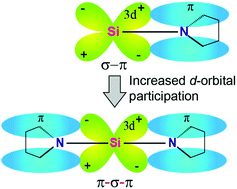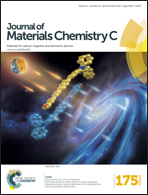Direct silicon–nitrogen bonded host materials with enhanced σ–π conjugation for blue phosphorescent organic light-emitting diodes†
Abstract
Silicon-containing ultrahigh-energy gap hosts (UGHs) have emerged as important candidates of high-performance host materials with high thermal stability and triplet energy for blue phosphorescent organic light-emitting diodes (PhOLEDs). However, the highest occupied molecular orbital (HOMO) of these UGHs are generally too deep to support balanced hole injection and transportation in devices. Here, we propose a new design strategy of UGHs by multiple introduction of strong electron-donating and high-triplet-energy units of carbazoles into the electron-accepting arylsilanes in the N–Si–N structure. The facilely synthesized carbazole-arylsilanes in one-step show high thermal stability, triplet energy and charge mobilities with high-lying HOMOs due to enhanced σ–π conjugation in the N–Si–N structure as revealed by combined experimental and theoretical investigations. Impressively, blue PhOLEDs hosted by these novel N–Si–N bonded UGHs exhibit an improved maximum current efficiency up to 39.5 cd A−1, a power efficiency of 27.4 lm W−1, and an external quantum efficiency of 24.2%, demonstrating significant advances in the design of UGHs by adjusting the d-orbital participation of π-conjugation to enhance the σ–π conjugation in donor (D)–acceptor (A) molecular architectures.


 Please wait while we load your content...
Please wait while we load your content...